The Art of Pricing
- 17 February 2016
- ByLauren Rose

Pricing communicates the value and quality of your work - it really is more than just a number. You can win or lose customers the moment they look at your price tag, so the importance of smart pricing can't be understated.
Are you getting started from the very beginning with pricing your products? Check out our in-depth guide on how to price your products to get a better grasp on the ins and outs of the process. If you're in a hurry and want a few quick pointers, read on.
The basics
A helpful formula to get started looks like this:
Materials + Labor + Expenses + Profit = Wholesale
Wholesale total x 2 = Retail
Materials
What went into making an individual product? For this one you can add up material hard costs (fabric, thread, buttons, or any other materials you use) and divide by how many products you made from all of that.
If you spent $100 buying materials and made 50 items, then you used $2 of materials on each one. Not everything will be as cut and dry as this, but try to find a number that best reflects the dollar amount of materials in each individual piece.
Labor
Your time, experience, and quality of work are among the many skills you possess that are worth money. Let's say in 1 hour you can make 5 products, and your time is worth $20 an hour. Then the labor per product is $4.
Expenses
Don't overlook all the additional expenses that come into play when making your products. Ask yourself “Who? What? Where? How?” questions to see where your time and money goes. Who helps you? What do you do to get your products out there? Where do you create your products? And how do you source your materials?
Profit
You have to get paid, right? The value of your time and unique point of view is worth something, so don't shortchange yourself just to keep costs down.
Need more help?
Worried your final wholesale or retail price is too high for the market? Wait! Don’t make a hasty judgment call and lower your price to match the market. Instead, look at how you got to that price, and figure out how you can lower the cost of making your product.
Can you buy bulk materials to save money? Can you share your studio to save on rent? Are you paying your best buds to ship orders, when you could be shipping them yourself? If lowering costs isn’t an option, then maybe take some time to consider if this is a sustainable product for the long haul.
And remember, if any of those terms or ideas read like a foreign language to you, we'd highly recommend taking a peek at our guide on pricing your products - it'll walk you through each aspect in more detail.
17 February 2016
Words by:Lauren Rose
Tags
- Share